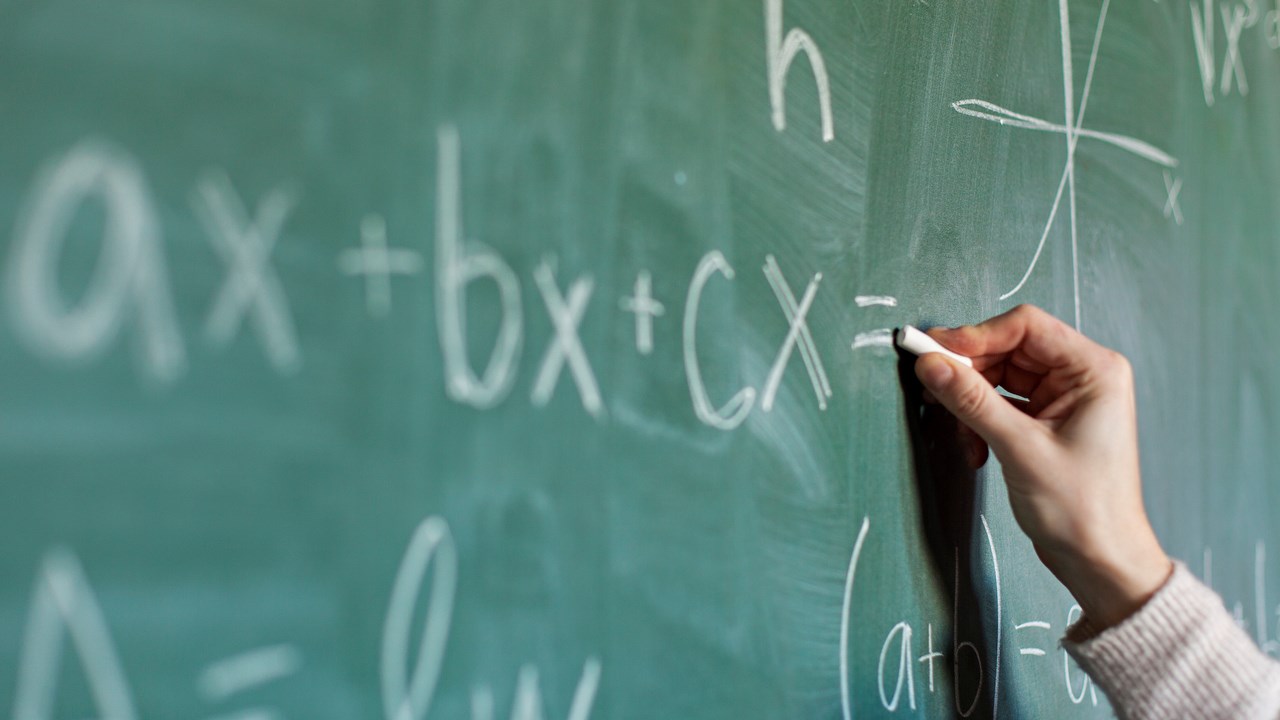
Image: Andreas Nilsson

Image: Andreas Nilsson
This webpage provides an overview of our department's history, detailing the development of our academic and research endeavors.
Location and organizational domicile
The Department of Mathematics at Umeå University started their activity in the fall of 1963 in the northern pavilions at Axtorpsvägen. In April 1968, the department moved to new premises in the Social Sciences Building, and in May 1994, it relocated to the newly constructed Mathematics and Information Technology (MIT) Building.

The northern pavilions 1963-1968
ImageOkänd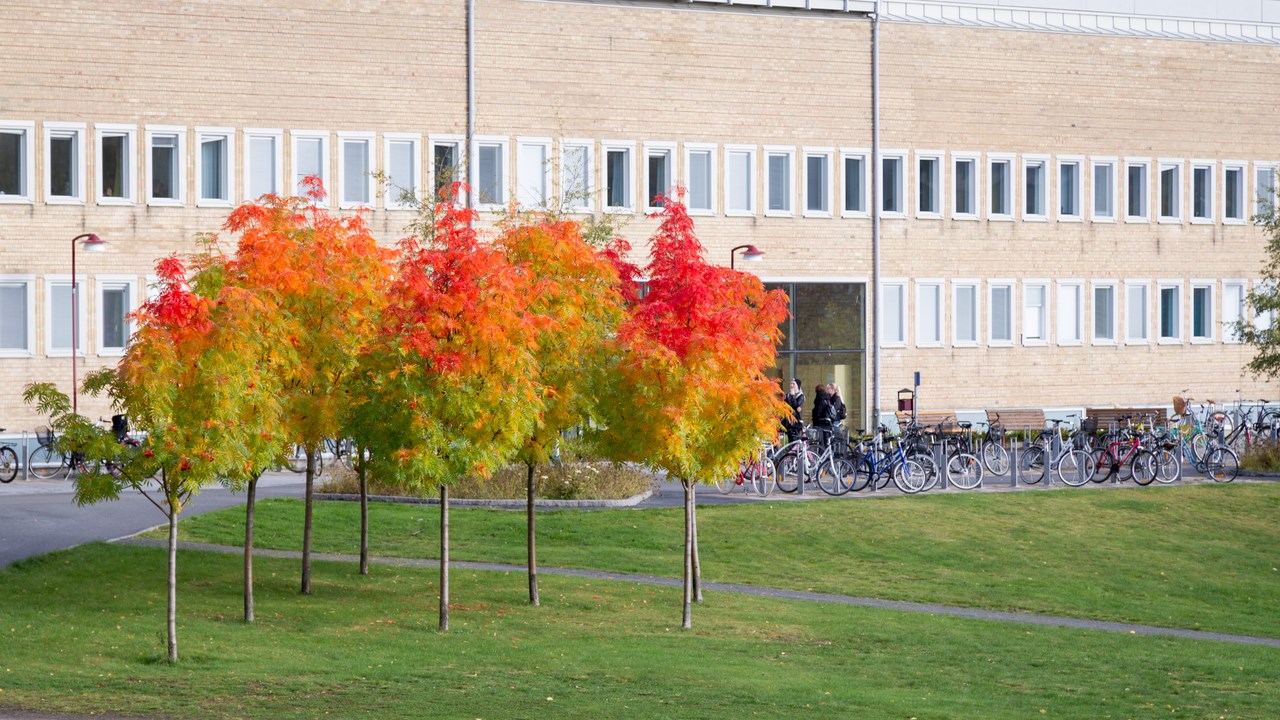
Social Sciences Building April 1968 - April 1994
ImageUlrika BergforsInitially, the department was part of the Faculty of Philosophy. In the fall of 1966, the Department of Mathematics and Statistics was established, which included sections for mathematics, mathematical statistics, statistics, and later, information processing. In 1977, this large department was divided into four separate departments.
The Faculty of Philosophy was divided in the fall of 1968, and since then, the department of mathematics has belonged to the Faculty of Science and Technology. From 2005, the departments of mathematics and mathematical statistics were once again merged into the Department of Mathematics and Mathematical Statistics.
The number of employees increased dramatically in the beginning, especially during the years 1963 to 1995, when the department grew from 5 to 50 employees. In the years following the merger with mathematical statistics, the number of employees ranged between 75 and 85 individuals, reaching the milestone of 100 employees in 2023.
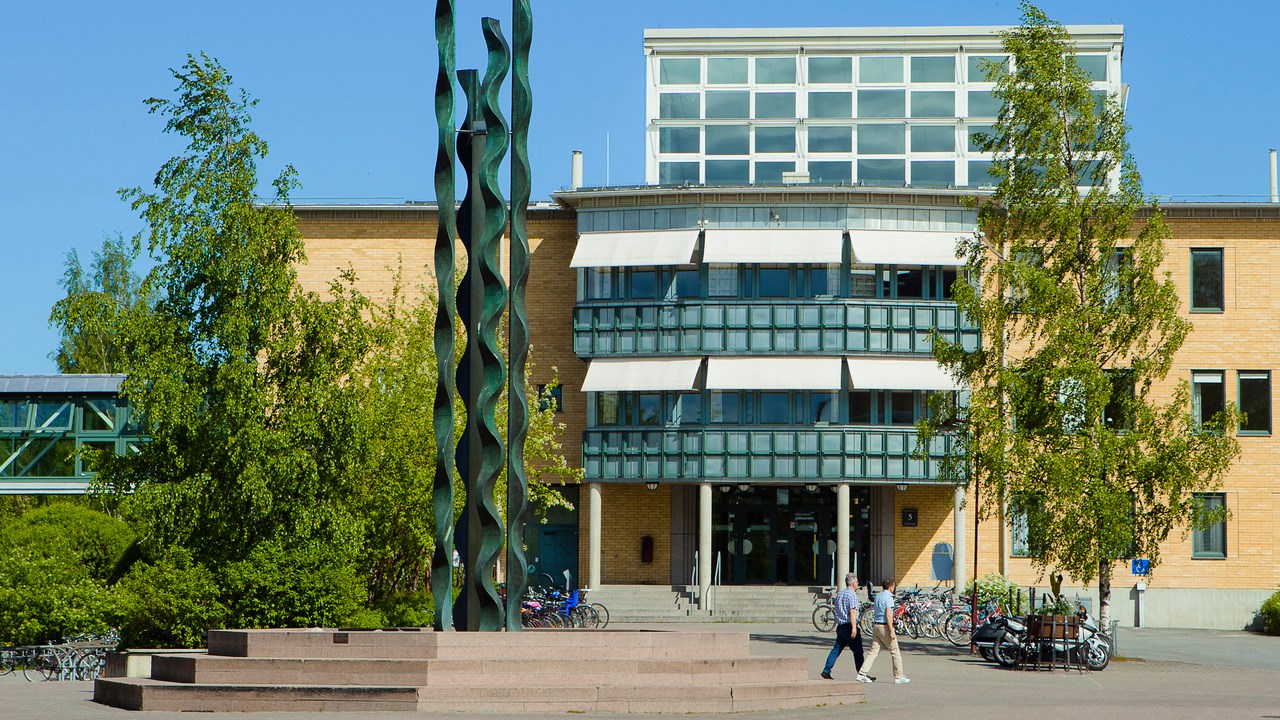
MIT Building May 1994-
Education and students
One-grade teaching (equivalent to one semester's study) began in the autumn of 1963, two-grade teaching in the spring of 1964, three-grade teaching in the autumn of 1964 and teaching for four grades in the autumn of 1965. In the autumn of 1977, in accordance with a decision by the parliament, the three-year programme “Matematikerlinjen” was established, in which mathematics and mathematical statistics were two of the main subjects. This was later replaced by the mathematical and natural science programme (“Matematisk-naturvetenskaplig linje”), the mathematician programme (Matematikerprogrammet), the mathematical statistician programme (Matematisk statistikerprogrammet) and the four-year master's programme in applied mathematics (Tillämpad matematik). With the Bologna reform in 2007, we switched to a 3+2 system (basic + advanced level). At the basic level, the bachelor's Programme in Physics and Applied Mathematics (Tillämpad matematik och fysik) was started, which was later removed and eventually returned in its current form without physics, the bachelor's Programme in Mathematics (kandidatprogrammet i matematik). At the advanced level, the master's programme in Computational Science and Engineering was started together with the departments of physics and computer science. It was also eventually closed, and we now have the more refined master's programmes in Mathematics and Mathematical Statistics. We also offer a track in data science in the master's programme in Artificial Intelligence.
Mathematics is included as the first subject in most Master of Science in Engineering and Bachelor of Science in Engineering programmes, in teacher training programmes and in many natural science programmes, and can also be taken as a freestanding course. Among the Master of Science in Engineering programmes, special mention should be made of Industrial Engineering and Management. The programme was launched in 2009 on the initiative of the department. It is the most mathematics-intensive of its kind in Sweden and is administered by our department. The number of applicants is among the highest at the faculty, and the students who have graduated have generally been very attractive in the labour market. As of 2023, approximately 470 students have graduated from the programme.
The total number of undergraduate students has undergone major changes over the years, from about 30 students in 1963 to between 1600 and 1700 students in 1996 - 2002 (with registrations for courses from 5 to 20 credits per semester). In 2003, the number of students dropped to 1400. In 2004, the number of students was 1611. As of 2005, students in mathematical statistics are also included in the figures, and from 2009 onwards, the number of students is reported in the number of HST, i.e. converted to full-time equivalent students. In 2009, the number of HST was 297 and since then it has almost doubled to about 534 in 2024. In addition, there are about 200 students who follow the Foundation Year in Science and Technology, and elements of mathematics and mathematical statistics are taught on a number of courses with other courses offering departments.
Doctoral studies in mathematics began in the spring of 1967, and the first dissertation took place in 1972. The doctoral programme in mathematical statistics began in the autumn of 1968 and the first dissertation took place in 1975. Between 1972 and 2023, a total of 114 Ph D students completed doctoral degrees at the department.
Professors and subject representatives
The department was, in 1963 to spring 1964, led by Acting Professor Einar Lunell and from fall 1964 to fall 1966 by Acting Professor Arne Nordlander. In the spring of 1967, Hans Wallin assumed the regular professorship in mathematics. Wallin retired on November 30, 2002, but while waiting for the professorship to be advertised and filled, he continued to be employed as a professor until November 2003. A new professorship was filled by Mats G Larson in October 2004, who also serves as the subject representative for the mathematics discipline.
Other professors who have been or are active at the department in its current form include Roland Häggkvist, professor in discrete mathematics from May 1989 until retirement in February 2017; Urban Cegrell, professor in complex analysis from April 1997 until retirement in May 2010; Johan Lithner, professor in mathematics education from 2004 to 2005 when the professorship moved to the Department of Science and Mathematics Education; Yuriy Rogovchenko, professor in mathematics from February 2010 to January 2013 (transitioned to another position); Kaj Nyström, professor in mathematics, from September 2010 to August 2011 (transitioned to another position); Lennart Bondesson, professor in mathematical statistics from October 1998 to retirement in June 2009; Sara de Luna, professor in mathematical statistics from December 2009; Jun Yu, professor in mathematical statistics from May 2012; Oleg Seleznjev, professor in mathematical statistics from May 2012 to retirement in June 2022; Åke Brännström, professor in interdisciplinary mathematics since October 2017; Klas Markström, professor in discrete mathematics since January 2020; Christian Ewald, professor in financial mathematics since March 2022; Patrik Rydén, professor in mathematical statistics since February 2023.
In 2024, the department's research is divided into five research areas: Mathematical Statistics, Discrete Mathematics, Mathematical Modeling and Analysis, Computational Mathematics, and the newly established research area Mathematical Foundations for Artificial Intelligence.
Mathematical Statistics
Mathematical statistics was established as a subject at Umeå University in 1966. Gunnar Kulldorff became the first professor in the subject (1966 -1993), placed at the then Department of mathematics and statistics. Research was initially conducted in inference theory (sampling theory, ordinal values and maximum spacing estimators). As new professors were installed, the research was broadened with new directions: Yuri Belyaev (1993-1998) in reliability theory, survival analysis and resampling methods, Lennart Bondesson (1998-2012) in distribution theory and sampling theory (Bondesson was also editor-in-chief of the Scandinavian Journal of Statistics 2001-2003), Sara Sjöstedt de Luna (2009 -) in spatial statistics and functional data analysis, Jun Yu (2012 -) in statistical learning and inference for spatiotemporal data, Oleg Seleznjev (2012 - 2023) in stochastic modeling of random functions and large databases, and Patrik Rydén (2023 - ) cluster analysis and data-driven decision-making.
Mathematical statistics in Umeå is characterized, among other things, by stable and valuable collaboration with the subjects statistics and mathematics regarding education and supervision at postgraduate and undergraduate level, seminar series and consultation. Another important collaboration is the popular winter conferences in statistics and mathematical statistics, which have been recurring since 1968, and are organized jointly with the Statistics division at the School of Economics, in a lovely mountain environment. Two successful Nordic conferences (NordStat) in mathematical statistics have also been arranged in Umeå in 1969 and 2012.
During the 1990s, there were strong influences from the "Russian school" via Belyaev (who was a doctoral student of Kolmogorov in Moscow and has supervised 30 doctoral students himself), Seleznjev and Dmitrii Silvestrov. Added to this are many visiting researchers and teachers from the former Eastern European countries. It is a result of Kulldorff's strong international commitment (he was, among other things, president of the International Statistical Institute, 1989-1991), to build up statistical competence in, for example, sample theory in these countries. As a result of this work, Professor Imbi Traat, Estonia, was appointed to honorary doctor at Umeå University in 2013.
During the last twenty years, the research directions have been broadened with modern statistics and many interdisciplinary research collaborations, for example with biology, computer science, ecology, medical science, forest science and technology. For his collaboration with researchers at the department, the former student at Umeå University Martin Kulldorff, Brownstone Institute was appointed to honorary doctor in 2022. There has also been collaboration with several external actors, e.g. Volvo, Forum, several regions and county administrations in the Nordics, Konftel, SOS Alarm, and Trafikverket.
Today, our work focuses on developing statistical theory and methods for high-dimensional data with complex structures, e.g. spatio-temporal data, functional data, genomic data, and mathematical foundations of data science. Here, the national research initiatives WASP, WISE and DDLS, in AI and data-driven life sciences and material sciences, are very important funding sources.
Analysis
Research at the Department of Mathematics began when Hans Wallin took up the post of professor in 1967. In the early years, the activities were strongly linked to the research that Hans had conducted after his dissertation in Uppsala in 1963. One can describe the area as potential theory and function theory in real variables. The first two doctoral theses that were fully produced at the department dealt with problems in this area. Research in the area developed and specialized in different directions during the following decades. Some of the specializations were classical function spaces on fractal sets, atomic decompositions, iterative function systems and fractals. During its time, this research took a very strong position in its field, both nationally and internationally, and was known as the Umeå School. In total, more than fifteen doctoral theses in analysis were produced with Hans Wallin as supervisor.
Successful research was also initiated by Ingemar Wik, who was one of the first lecturers at the department. His specialty was harmonic analysis, in which area he supervised several doctoral students in the early years of the department.
Complex analysis
Complex analysis in one variable has a long-standing tradition at Umeå University, dating back to the 1960s with Hans Wallin's influential research group in analysis. The arrival of Urban Cegrell in 1984 marked an expansion into complex analysis of several variables. This new direction attracted a host of talented PhD students, including Johan Thorbiörnson, Leif Persson, Ulf Backlund, Anders Fällström, Magnus Carlehed, Frank Wikström, Ewa Bergqvist, Jonas Wiklund, Per Åhag, Linus Carlsson, Berit Bengtson, Lisa Hed, and Pham Hoang Hiep, along with Yang Xing, who collectively propelled the group to become one of Sweden's most prominent in the field. Their research predominantly focused on pluripotential theory, function theory, and the study of ideals and spectra for algebras of holomorphic functions.
Cegrell's appointment as a professor in 1997, with a concurrent position at Mid Sweden University, fostered unique synergy between the groups in Sundsvall and Umeå. The research group distinguished itself through its mathematical achievements and a vibrant social and academic culture. They hosted numerous seminars, workshops, and international conferences, ranging from informal gatherings like "Linus's Little," "Complex Breakfast," and "Bulletproof Pizza Night" to regular series with esteemed international guests. Notably, in 2005, Linus Carlsson and Berit Bengtson inaugurated the annual Nordic conference, KAUS - Complex Analysis Without Seniors, designed to encourage doctoral students to engage and collaborate without the presence of senior researchers. The group also organized the Nordic Complex Analysis Meeting (Nordan) several times, including a special edition 2012 to celebrate Cegrell's retirement.
Following Cegrell's retirement, Per Åhag has continued the legacy, focusing on several complex variables, pluripotential theory, and differential geometry. The recent addition of Antti Perälä and Jakob Hultgren has resurrected the group. Perälä's research centers on functional analysis, complex variables, and operator theory, delving into the properties and spectra of various concrete operators, such as Toeplitz, Hankel, and Volterra, defined on spaces of analytic functions. Hultgren focuses on complex geometry, exploring topics like canonical metrics on complex manifolds, degenerate families of Calabi-Yau manifolds, and a wide range of applications.
Discrete Mathematics
Prehistory
The history of discrete mathematics in Umeå begins with Roland Häggkvist, who defended a PhD thesis at the department in the late 1970s entitled On Factors and Cycles in Graphs and Digraphs, despite the fact that there was no graph theorist employed there (or indeed in Sweden) at the time.
Roland managed this feat by studying under Gabriel Andrew Dirac (of Dirac’s theorem fame) in Aarhus while under the nominal supervision of Hans Wallin in Umeå. After working at Cambridge, Rutgers and Waterloo, He later returned to Sweden and held positions at KTH and Stockholm University. Roland returned to Umeå in 1989 to take up a professorship in discrete mathematics, as one of two new professors funded by a government plan to support the development of IT .
An innovative aspect of Roland’s research was his use of computational methods in graph theory, a novel approach at the time. Roland’s influence in this respect can still be glimpsed today in some of the work of his former students, and in particular in research involving large-scale computations that has been carried out at HPC2N, the local supercomputing centre, by current group members.
Formation of the discrete group
Roland’s appointment as professor of discrete mathematics at Umeå university in 1989 marked the beginning of the discrete mathematics group proper. From then on until his retirement in 2017, Roland supervised a dozen PhD students in Umeå across a range of topics within discrete mathematics, from graph theory (notably problems on cycles and factors in graphs and on graph colouring), design theory (especially Latin squares, the subject of a celebrated conjecture of Evans that Roland settled for large n), and the interaction of discrete mathematics and statistical physics (in particular the study of the Ising model).
In addition Roland, the early constellation of senior researchers in the discrete group included Sean McGuinness and Armen Asratian.
Roland put Umeå on the map of graph theory and combinatorial research, and exerted a lasting influence on the discrete mathematics group in Umeå. His former students Klas Markström, Per-Håkan Lundow, Lars-Daniel Öhman and Robert Johansson are all current members of the group, and continue to be active in Roland’s areas of predilection.
Beyond Umeå, a number of Roland’s former students are present in other Swedish Universities, and include Anders Johansson (who proved the Johansson bound on the list-chromatic number of triangle-free graphs while a student of Roland’s in Umeå, and the celebrated Johansson–Kahn–Vu theorem during his time as a visiting researcher in Umeå) at Gävle, Carl-Johan Casselgren in Linköping and Daniel Andrén, Lina Jansson Andrén and Lars Hellström at Mälardalen.
In addition to his supervision of PhD students, Roland frequently invited visiting researchers to Umeå. A connection between Umeå and Cambridge dates back to this time, with Béla Bollobás, Andrew Thomason, Tristan Denley and Jonathan Cutler all visiting Umeå in the 1990s and early 2000s, and Klas Markström going the other way in 2003 after his PhD and spending a year in England with Andrew Thomason.
Consolidation
When returning to Umeå, Klas took up the baton from Roland and began to introduce new directions of research, notably in extremal hypergraph theory. Klas also continued to cultivate the links between Umeå and the British research community in extremal and probabilistic combinatorics. Over the years, he hosted a succession of British-trained postdocs and long-term visitors: Demetres Christofides, Robert Johnson, Allan Lo, Victor Falgas-Ravry, Trevor Pinto, Jakub Sliacan and most recently Eero Räty.
Klas was also active on a number of other fronts, being elected a fellow of the Young Academy of Sweden in 2012, organising a semester-long programme on graphs, hypergraphs and set systems at the Mittag—Leffler Institute in 2014, and serving a term as president of the Swedish Mathematical Society from 2016 to 2018. Following the graduation of his PhD students Lan Anh Pham and Joel Larsson, he was subsequently promoted to full professor in 2020.
Joining Robert Johansson, who had stayed in Umeå, Roland’s former students Lars-Daniel (who became associate professor in 2009 after working at Ole Miss and Mid-Sweden University) and Per-Håkan (who returned to the department from KTH in 2014) brought for their respective parts research focus on design theory and (more exotically!) the philosophy of mathematics, and on models from statistical physics.
In 2011, Gerold Jäger joined the discrete mathematics group from TU Claustahl in Germany, bringing in new research expertise in optimisation, algorithms, TSP, sensitivity analysis and game theory. Over the years, he supervised two postdocs, Ahmad Hosseini and Valentin Gledel, and two PhD students, Denys Shcherbak and currently Dmitrii Panasenko, and developed fruitful collaborations with the computer science department.
Recent developments
In the wake of Roland’s retirement, the discrete group began a period of gradual expansion starting in 2016 with Victor Falgas-Ravry joining Umeå from Vanderbilt University in the US, followed by Klara Stokes from Maynooth in Ireland in 2020, Maryam Sharifzadeh from the University of Birmingham in the UK in 2021, Henrik Gustafsson from the University of Gothenburg in 2022, and István Tomon from ETH Zürich also in 2022, leading to the current high water mark in terms of the group’s size: ten permanent members, five PhD students, one visiting PhD student and two postdocs, with yet another PhD student and three postdocs set to arrive in 2024.
New members brought new ideas, research interests and collaborations, contributing to a revival of the Discrete Seminar and the current flourishing state of discrete mathematics in Umeå.
Victor set up an exchange agreement with the University of Birmingham, which led to Robert Hancock, Nicolás Sanhueza-Matamala and Vincent Pfenninger each spending a semester in Umeå. Victor also advised a postdoc, Nick Day, and currently supervises a PhD student Altar Çiçeksiz. Together with Klas Markström, he hosted a longer guest professor visit by Yi Zhao from Georgia State University and initiated the now yearly Midwinter Meeting in Discrete Probability, gathering probabilists from across Sweden in Umeå in January every year.
Klara built up a research profile for Umeå in discrete geometry, assembling a dynamic group currently consisting of her PhD students Signe Lundqvist and Joannes Vermant and her postdoc Tovohery Randrianarisoa, and hosting a long-term visit in Umeå by Dimitri Leemans as a Wallenberg guest professor.
Maryam brought expertise in the theory of graph limits and hypergraph regularity to Umeå. With Victor, she hosted a long-term research visit by Leila Badakhshian. Together with Klas, Victor, Andrew Treglown and Yi Zhao she also recently organised a Mittag-Leffler workshop on extremal combinatorics.
Henrik for his part introduced a new research area on representation theory and number theory, with connections to statistical physics, on which he works together with his PhD student Carl Westerlund.
István brought additional depth and breath to research in extremal and probabilistic combinatorics, in particular when it comes to the use of algebraic methods and to applications to combinatorial geometry, Ramsey theory and poset theory. He was awarded the European Prize in Combinatorics in 2021, shortly before joining the department.
Currently, several post-docs are inbound, there are frequent visits by guest researchers from abroad and significant levels of external and faculty funding flowing to the research oft the group, and the discrete mathematics is thriving in Umeå.
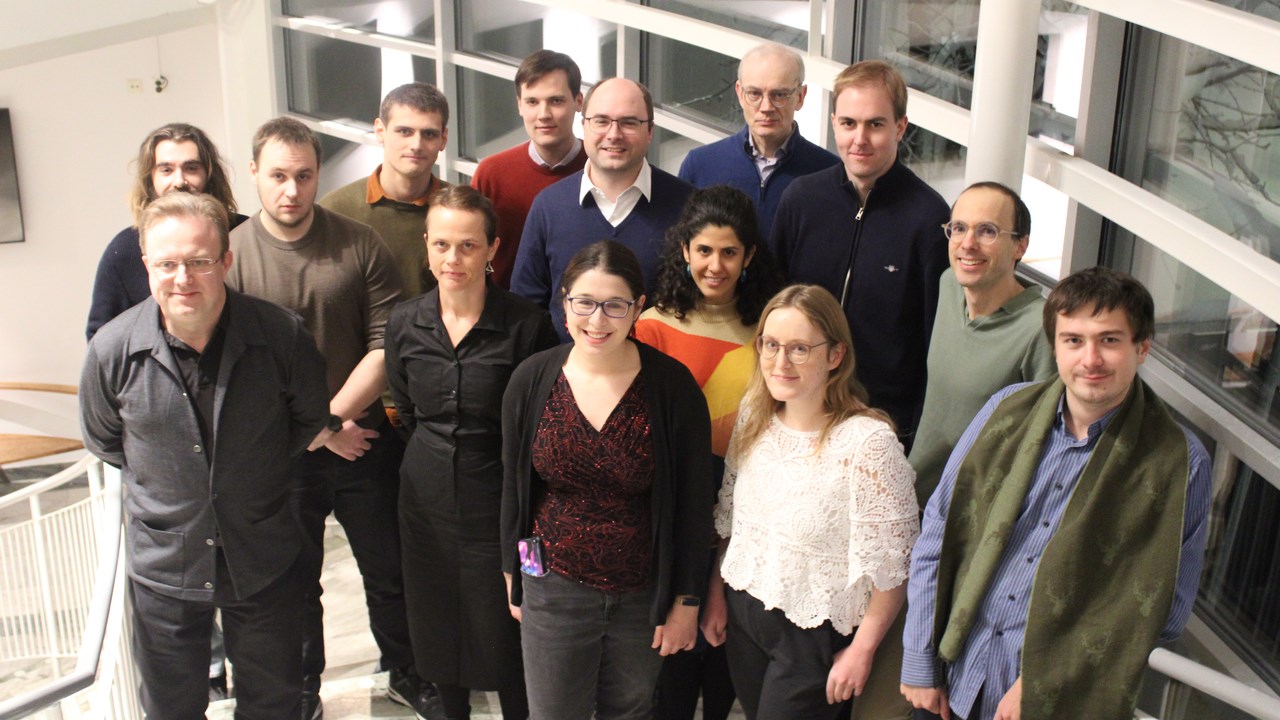
The Discrete Mathematics research group is a large and active research group with a weekly seminar and a frequent flow of visitors, students and postdocs.
ImageNorea ÅhlinNotable external activities of discrete group members
Discrete mathematicians have contributed to the running of the department, with Robert serving as head of department for two terms and Klas as deputy head for one term. The faculty of technology and natural sciences has also been graced by the presence of discrete mathematicians, with Lars-Daniel currently serving on the faculty board, and previously on the undergraduate education committee, and Per-Håkan serving on the Employment committee. On the national level, discrete mathematics members have represented Umeå in the National Committee for Mathematics, where both Klas and Klara has served, and Lars-Daniel is set to chair the Swedish branch of the International Congress for Mathematics Instruction.
Finally it would be remiss not to mention that members of the discrete mathematics have been heavily involved in activities related to mathematics competitions for high-school students. Klara, together with Eero and István (former IMO participants themselves), and Victor, currently run a course preparing students for competitions, once initiated by Lars-Daniel, who is also on the committee organising the Swedish qualification round for IMO.
Mathematical Biology
The establishment of mathematical biology as a viable research field began with a fortunate coincidence. In 1999, Anders Öberg went to Manchester as a postdoc. There, he met a doctoral student in the field, David Sumpter, and told him about Umeå University. David found Umeå exotic, and when Anders invited him to a small research meeting with SLU, he accepted immediately. In 2001, David applied for and received a postdoctoral scholarship from STINT for a one-year stay at the Department of Mathematics. David enjoyed his time in Umeå, and when he met Lovisa Ulfsdotter, a doctoral student in mathematics education, he chose to stay as a research assistant.
At that time, Åke Brännström was a doctoral student in the middle of his studies. His supervisor had left the department for the business sector. Hans Wallin suggested that Åke should contact David, and with guidance from David, Åke completed his thesis in mathematical biology. During this period, Anders Johansson also began working with David on questions related to population dynamics. In 2004, David started a position at Oxford University, but he regularly visited Umeå. In 2007, David became a professor of applied mathematics at Uppsala University.
After postdoc stays in Austria and Japan, Åke was employed as a research assistant in mathematical biology in 2007, and the activities slowly resumed. Åke has been an associate professor since 2010 and became a full professor in 2017. That same year, Eric Libby was recruited to the department as an associate professor. He has since built up a large and active research group that focuses on the evolution of biological complexity, such as the origin of multicellularity. Today, there are 4 doctoral students and 2 postdoctoral researchers working in the field, and most activities take place within the interdisciplinary research environment IceLab. The research primarily focuses on ecological and evolutionary modeling.
In the 20 years since David first came to Umeå, mathematical biology has grown significantly across Sweden, with the research field now present at least in four major Swedish universities, and everything indicates that it will continue to grow in the coming years.
Computational Mathematics
In connection with Hans Wallin's retirement in the early 2000s, a new professorship was announced at the department. Mats G. Larson was recruited from Chalmers for this position, and he assumed the role of professor of applied mathematics and also as representative for the mathematic subject in 2004. This marked the starting point for research in computational mathematics at Umeå University.
At that time, Chalmers constituted perhaps the strongest research environment in computational mathematics in Europe, with the analysis of so-called finite element methods at its core. Larson's recruitment established this successful school in Umeå as well. Finite element methods are used, with the help of computers, to calculate solutions to partial differential equations that model fundamental physical phenomena with important applications, such as in fluid mechanics and structural mechanics. A central aspect in the development of such methods is that they are based on mathematical analysis, which provides reliable and robust methods, and ensures that the solutions they generate have a guaranteed high accuracy. Over the years, a number of doctoral students (Fredrik Bengzon, August Johanson, Robert Söderlund, Håkan Jakobsson, Karl Larsson, Tobias Jonsson) and postdoctoral researchers (André Massing, Daniel Elfverson, Ceren Gürkan) have been part of Larson's group. Of these, Karl Larsson continues to work at the department as a university lecturer in computational mathematics.
A research line pursued in Umeå, which has garnered significant attention in the research world, is the development of so-called Cut Finite Element Methods (CutFEM), which decouple the geometric description of the domain in finite element methods from the approximation space for the solution. Larson was awarded a research grant in 2015 from the Foundation for Strategic Research's for this theme, together with co-applicants Martin Berggren (Umeå University), Anders Klarbring (Linköping University), and Peter Hansbo (Jönköping University).
A significant transformation of the research environment occurred in 2011 with the establishment of the UMIT Research Lab. Researchers from various departments of the university were brought together under the common denominator of working with computer simulations in various forms. With the initiation of UMIT, the opportunity arose to hire Christian Engström from ETH Zürich in 2011 as an associate professor with a research focus on eigenvalue problems. During his time in Umeå, Engström supervised two doctoral students (Axel Torshage, Juan Carlos Araujo-Cabarcas) and is currently a professor at Linnaeus University. The following year, the research received additional influences with the appointment of David Cohen from the University of Basel as a university lecturer with a research focus on stochastic differential equations. During his time in Umeå, Cohen supervised two doctoral students (Rickard Anton, André Berg) and is now a professor at Chalmers University of Technology.
In recent times, the department's research in computational mathematics has also been influenced by Uppsala University, with the hiring of Siyang Wang as an associate professor in 2021. Finite difference methods, a strong research area at Uppsala University, have contributed to the current research landscape. Currently, two doctoral students (Jonatan Vallin, Andreas Granath) and three postdoctoral researchers (Carl Lundholm, Balaje Kalyanaraman, Shantiram Mahata) are active in computational mathematics.
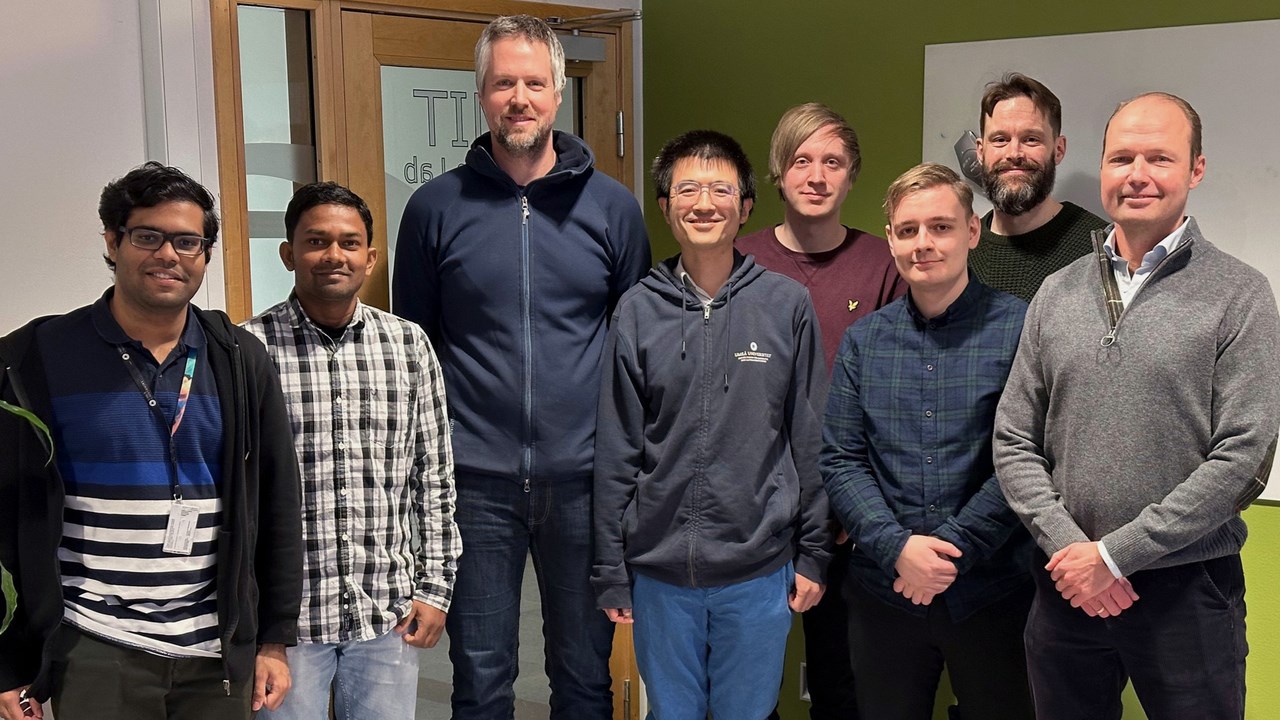
The Computational Mathematics research group today. From the left: Balaje Kalyanaraman, hantiram Mahata, Karl Larsson, Siyang Wang, Jonatan Vallin, Andreas Granath, Carl Lundholm and Mats G Larson.
ImageMikael LundbäckFinancial Mathematics
When the Master's program in Industrial Economics started in 2010 (with one of its specializations being risk management) there was an increased demand for expertise in the field of financial mathematics. In March 2022, Christian Ewald was hired as a professor in financial mathematics and began establishing a new research group in the subject. The research include work in financial mathematics, quantitative finance, risk management, and commodities and currently one doctoral student (Abigail Berta) and a postdoc (Kevin Kamm) are active in the research group.
Mathematical Foundations of Artificial Intelligence
Mathematical Foundations of Artificial Intelligence is the youngest research area in the department, formed in late 2022. Its emergence is tightly connected to the national strategic program WASP (Wallenberg AI, Autonomous Systems, and Software Program) of the Knut and Alice Wallenberg Foundation, which provides funds for both senior and junior researchers in the group. The research is focused on mathematical questions concerning the quickly developing field of artificial intelligence and machine learning. Particular areas of interest include equivariance in neural networks, as well as non-convex and non-smooth optimization. The group is growing and currently consists of assistant professors Alp Yurtsever and Axel Flinth and associate professor Fredrik Ohlsson.
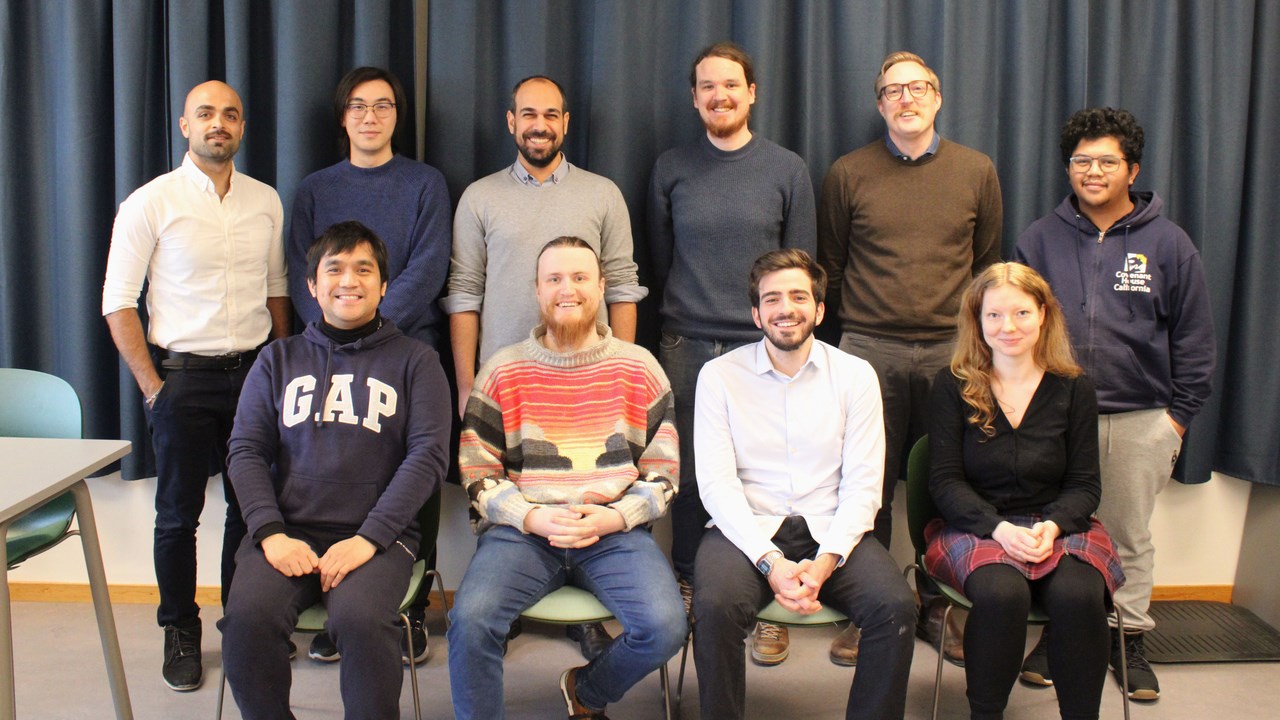
The Mathematical Foundations of Artificial Intelligence research group
ImageNorea ÅhlinMathematics Education
The research activities in mathematics education at Umeå University were initiated in 1994 by Hans Wallin. The purpose was to complement the educational science research, which at that time in Sweden was primarily conducted at pedagogical departments, by conducting research that could better address questions requiring deeper mathematical expertise. In 1995, probably the first formalized subject-didactic doctoral program at a subject department in Sweden was established at the Department of Mathematics in Umeå. This has since become relatively common at Swedish universities and in many subjects. The goal was to contribute to knowledge about and the development of mathematics education, primarily at the high school and university levels.
Since then, the research group has evolved to include a large number of participants from several departments conducting mathematics education research at all levels of education. The Umeå Research Center for Mathematics Education (UFM) was established in 2006 by the university's vice-chancellor to strengthen ongoing development. Hans Wallin's long-standing and extensive commitment to the field of mathematics education has also had an impact beyond Umeå University, especially in the establishment and implementation of the Riksbankens Jubileumsfond national research school in Mathematics Education.
An example of UFM's research is the project "Learning by imitative and creative reasoning", conducted in collaboration between researchers from neuroscience, psychology, and mathematics education. The project addresses the problem of inefficient learning through imitation of algorithmic procedures (often without understanding the underlying mathematics), which dominates in Swedish and many foreign classrooms. It explores possibilities for designing more effective teaching where students are encouraged to reason and derive conclusions on their own.
In 2005, the research in mathematics education moved to the Department of Science and Mathematics Education, along with Professor Johan Lithner and additional researchers in mathematics education. However, collaboration still continues between researchers at the two departments.
